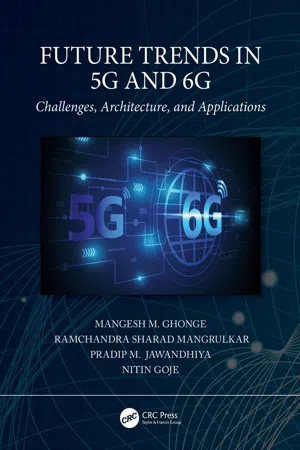
Future Trends in 5G and 6G
Challenges, Architecture, and Applications
- 342 pages
- English
- ePUB (mobile friendly)
- Available on iOS & Android
Future Trends in 5G and 6G
Challenges, Architecture, and Applications
About This Book
This bookoffers a comprehensive overview of basic communication and networking technologies. It focuses on emerging technologies, such as Software-Defined Network (SDN)-based ad hoc networks, 5G, Machine Learning, and Deep Learning solutions for communication and networking, Cloud Computing, etc. It also includes discussions on practical and innovative applications, including Network Security, Smart Cities, e-health, and Intelligent Systems.
Future Trends in 5G and 6G: Challenges, Architecture, and Applications addresses several key issues in SDN energy-efficient systems, the Internet of Things, Big Data, Cloud Computing and Virtualization, Machine Learning, Deep Learning, Cryptography, and 6G wireless technology and its future. It provides students, researchers, and practicing engineers with an expert guide to the fundamental concepts, challenges, architecture, applications, and state-of-the-art developments in communication and networking.
Frequently asked questions
Information
1 An Organized Study of Congestion Control Approaches in Wireless Sensor Networks
1.1 Introduction

1.1.1 Types of Applications [3]
1.1.2 Types of Congestion

Table of contents
- Cover
- Half Title
- Title Page
- Copyright Page
- Contents
- Preface
- Editors
- Contributors
- 1 An Organized Study of Congestion Control Approaches in Wireless Sensor Networks
- 2 NR: Architecture, Protocol, Challenges, and Applications
- 3 Comprehensive Survey on Device-to-Device Communication for Next- Generation Cellular Technology
- 4 Challenges, Opportunities, and Applications of 5G Network
- 5 Machine Learning and Deep Learning for Intelligent and Smart Applications
- 6 Key Parameters in 5G for Optimized Performance
- 7 Applications of Machine Learning in Wireless Communication: 5G and Beyond
- 8 GREEN-Cloud Computing (G-CC) Data Center and Its Architecture toward Efficient Usage of Energy
- 9 SDR Network & Network Function Virtualization for 5G Green Communication (5G-GC)
- 10 An Intensive Study of Dual Patch Antennas with Improved Isolation for 5G Mobile Communication Systems
- 11 Design of Improved Quadruple-Mode Bandpass Filter using Cavity Resonator for 5G Mid-Band Applications
- 12 Wavelet Transform for OFDM-IM under Hardware Impairments Performance Enhancement
- 13 A Systematic Review of 5G Opportunities, Architecture and Challenges
- 14 The Latest 6G Artificial Intelligence Network Applications
- 15 A Review of Artificial Intelligence Techniques for 6G Communications: Architecture, Security, and Potential Solutions
- 16 Layered Architecture and Issues in 6G
- 17 Artificial Intelligence Techniques for 6G
- 18 Antenna Array Design for Massive MIMO System in 5G Application
- Index